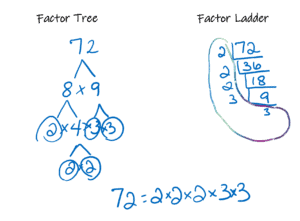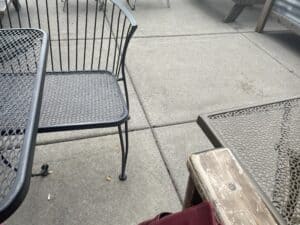(Click aqui para leer este articulo en español.)
Soon after they learn the basics of multiplication, your child will begin to learn about factoring in math class. You can think of factoring as a process of unmultiplying, or of showing the multiplication. (The factors are the numbers that get multiplied together, and the result of multiplying them is called the product.) The more fluent your child can become in factoring, the easier it will be for them to “keep up” in class with discussions of fractions, geometry, division, and more. There is a lot parents can do to help build this fluency. (For some ideas of building multiplication fact fluency, check out my post How to Learn Multiplication Facts.)
Parents can help their children learn to factor by using tools and models that allow them to count and add, by ensuring they learn their basic multiplication facts, by practicing dividing and division rules, by measuring rectangles, by using household items and online tools, and by playing games.
The great news is that all of these will benefit your children in ways that go far beyond learning to factor. Below are just a few examples of how parents might help their children build fluency in this all-important skill of factoring. This fluency is a base skill that will pay off throughout your child’s math education in both the near and farther future.
This post contains affiliate links. If you purchase through these links, I may earn a small commission at no additional cost to you. You can read more about how I choose affiliates and products at my affiliate page.
Use Tools and models that scaffold learning factoring
Just like adults, children love to feel success. Accomplishment helps us feel motivated to keep trying and learn more. Allow your children to use the tools they already feel accomplished in, such as counting, skip-counting, and adding to build their confidence and to master both the concepts and the facts at the pace that is right for them. Your child’s teacher has been using many tools specifically designed to scaffold this type of learning. Most of these are accessible to parents in everyday life as well, such as arrays and area model. Others are becoming more and more accessible at home thanks to sites such as polypad.org which provide online math manipulatives such as prime factor circles, number bars, and 10-frames, free of charge to educators, students, and parents.
- Count out a certain number of squares (such as upside-down Scrabble tiles, squares cut out of cardboard, dice, sugar cubes, square Legos, etc.) Have your child guess whether they can make a rectangle using exactly those squares with a side of a certain length. Then have them try. When they succeed making a perfect rectangle, recite together the related multiplication and division facts. This is an application of the Area Model of Multiplication.
- If you can’t find anything square, you can use anything at all (poker chips, paper clips, fridge magnets, coins, etc.), you can have your child build a rectangular Array and use it the same ways.
- Ask your child’s teacher about all of the models they may use in class to arrange the factors when they find them. Some common models are the factor tree and the factor ladder.

- Use online tools such as the Prime Factor Circles at polypad.org (under the “Numbers” tool menu) to explore sets of factors for any number.
Practice basic multiplication facts
Learning research has obliterated timed facts tests and the flashcards you may be used to. While these work for some students, they were leaving behind a tremendous number of students. The time pressure as well as the focus on memorization without understanding left many people who had previously enjoyed playing with numbers instead feeling defeated, joyless, even “dumb.” Instead, try some research-proven ideas to help your students learn basic multiplication facts. The payoff will be huge, and the earlier you start the better. Knowing these facts will begin to pay off immediately, not only in factoring but also in fractions, multiplying and dividing larger numbers, and eventually algebra and beyond. Learning the facts using research-based methods may feel slower than flashcards and timed tests, but the depth, understanding, and true ownership of that knowledge will leave your child more confident and more able to make use of it whenever it’s needed.
- Grab those objects you used above and have your child build as many different rectangles or rectangular arrays as they can. Each time they find a rectangle, recite the related multiplication and division facts together.
- Flashcards are okay when used appropriately and for short periods of time. Multiplication by Heart is a flashcard-style game built on solid learning research. It gives students scaffolds in the form of common school models to find success and build meaning for the individual facts. It also uses what’s called “spaced repetition,” where students are presented the individual multiplication facts at intervals that maximize their learning and retention. Both of these features make flashcard learning more fun, more effective, and more efficient.
Practice Dividing and Division Strategies
Turn those basic multiplication facts around and practice them as division as well. This can help your child learn the facts more deeply and make the facts quicker to access in a variety of contexts. In addition, practice division strategies (such as even numbers are divisible by two, or a number is a multiple of 3 if the digits add up to a multiple of three, etc.) Make it fun by looking up with your child the rules for testing division by 7. This one is not widely known, leaving it open for your child to use as a number “magic trick” for their friends.
Skip counting is also a great way to internalize which numbers are divisible by certain factors. Consider skip counting while jumping rope or other repetitive physical activities.
Measure rectangles
Grab a measuring stick or ruler. Find some rectangles. Measure the sides, multiply, and talk about area and volume. How many units of fencing do they need to give their Minecraft animals enough space? Or, turning that around, if they have 12 units of fencing, how much space can they give the animals? If they want space for a bed and two chests in their starter home, what dimensions can they use to build it? Minecraft and similar video games can be a great tool for this, but there are applications everywhere.

Children can play with these ideas even without the words perimeter or area. Let them generate these ideas on their own. Let them develop the need and desire for the words to explain these concepts, and then give them these words. It will pay off with a much deeper understanding and greater motivation to learn when it does come up in class.
Play games
- If your family is into board games, check out Prime Climb (affiliate link).
- Challenge your child to find the largest prime number they can. Then check it together.
- Play an online game such as Factris.
These are only a few examples of ways you can support your child in building factoring fluency. There are so many more! Comment below if you have other ways you support your child’s factoring fluency. Then keep reading this blog to learn more ways to talk math with your kids (#tmwyk).
You’ve Got This!
